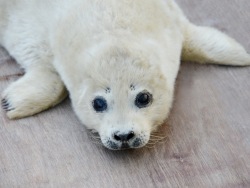World’s first success in captive breeding of the spotted seal

On the 6th of March the Aquarium’s female spotted seal (Phoca largha) delivered a pup. The newborn named Jupiter is a pioneer in many ways: it is the first marine mammal born at the Primorsky Aquarium, and it is the world’s first spotted seal conceived, gestated, born and reared in captivity.
“The conservation of ocean biodiversity is impossible without solid research,” said Sergey Loginov, Director of the Primorsky Aquarium. “Dozens of animal species are still extant only due to scientists who have learnt to breed them in artificial conditions. Previously, births of spotted seal pups were reported from some foreign aquariums but all the baby seals died during the first month of life. We managed to create proper conditions for a successful first pregnancy of the female spotted seal and for raising a breast-fed pup. A month prior to delivery our specialist maintained a round-the-clock watch on the animal, with several closed- circuit cameras installed; monitoring was conducted in accordance with the species’ biology.”
At birth Jupiter weighed 9 kg. During the first 3-4 weeks of life baby seals are nursed by their mothers and rapidly gain weight. The milk of spotted seals is very nutritious, with a fat content reaching 50% and a protein content of 15%. Jupiter put on 1.5-2 kg per day, and in a month he attained a weight of 37 kg.
After building up a fat store, baby seals have to survive the postweaning fast. Over a period of several weeks they moult, and their digestive system undergoes changes: pups lose their extra weight to reach a body mass of 25 kg or less that enables them to forage at sea.
While nursing, Varia, Jupiter’s mother, refused to eat. In the wild female seals do the same. Scientists believe that this defensive mechanism helps to preserve the composition of seal milk. Before giving birth to the pup, Varia weighed a little over 150 kg. After the baby was born, the female seal lost about 20 kg, and then she took off 45 kg more during 3 weeks of feeding.
“Observing the mother seal and her pup, we make “micro-discoveries” almost every day. The study material we have collected is unique,” said Igor Katin, Head of Research of the Marine Mammal Laboratory at the National Scientific Center of Marine Biology, FEB RAS, Lead Specialist of the Experimental Research Department at the Primorsky Aquarium. “And here, in Vladivostok, we have an opportunity, that is also unique, to see spotted seals in the wild; throughout the world there are very few cities, within which a carnivorous marine mammal can be found. Spotted seals inhabiting Peter the Great Bay constitute an isolated group that differs, even genetically, from other spotted seals occurring in the Far Eastern Seas. The distinct feature of our seals is that they breed on land, not on ice floes. Females deliver pups and nurse them only on the shores of desert isles in the Far Eastern Marine Reserve. Last autumn we set up some online cameras to watch wild spotted seals on one of the isles. As a result, we have become the first in the world to combine observational and experimental research and to compare the birthing behaviour in the female seals from the Reserve with that of the Aquarium’s Varia.”
Several days ago Jupiter was weaned. The pup has moulted, and now he is grayish silver like his parents. Varia enjoys gaining the lost weight: her diet consists of pink salmon, squid, herring and shrimps.
In addition to Jupiter and Varia, the Primorsky Aquarium is also a home to four spotted seals: Socrates, Plato, Kant and Dulcinea. Since 2015 the Aquarium specialists have been conducting scientific investigation (including studies in animal psychology) of marine mammals. For instance, the researchers have found out that lateralization of brain functions is typical not only of human beings: spotted seals may be “right-handed” or “left-handed” too.
General information
- The spotted seal (Phoca largha) is a species of true seal.
- The word “largha” in the Latin name is the term for this species which stems from the Tungus language.
- The spotted pattern is unique to each animal, like fingerprints in humans.
- The group of spotted seals from Peter the Great Bay numbers some 3,500-4,000 individuals. Most of them are migrants, only 20% of the seals spend summer in the bay.
- Local spotted seals were first mentioned in the newspaper Vladivostok in 1883. For a long time, the spotted seal was considered to be a subspecies of the harbor seal species; it was recognized as a separate species in the 1970s.